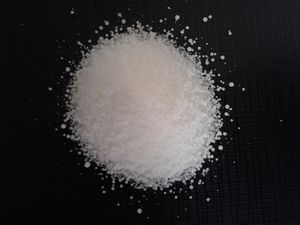Sodium bisulfate
 Sodium bisulfate from the store
| |
| Names | |
|---|---|
| IUPAC name
Sodium hydrogen sulfate
| |
| Other names
Bisulfate of soda
Sodium acid sulfate | |
| Properties | |
| NaHSO4 | |
| Molar mass | 120.06 g/mol (anhydrous) 138.07 g/mol (monohydrate) |
| Appearance | Colorless solid |
| Odor | Slight, acidic |
| Density | 2.742 g/cm3 (anhydrous) 1.8 g/cm3 (monohydrate) |
| Melting point | 58.5 °C (137.3 °F; 331.6 K) (monohydrate) 315 °C (599 °F; 588.15 K) (anhydrous, decomposes) |
| Boiling point | Decomposes |
| 28.5 g/100 ml (25 °C) 100 g/100 ml (100 °C) | |
| Solubility | Reacts with bases Insoluble in ammonia, ethanol, pyridine, toluene, xylene |
| Acidity (pKa) | 1.99 |
| Hazards | |
| Safety data sheet | Sigma-Aldrich |
| Flash point | Non-flammable |
| Lethal dose or concentration (LD, LC): | |
| LD50 (Median dose)
|
2490 mg/kg (rat, oral) |
| Related compounds | |
| Related compounds
|
Sodium sulfate |
| Except where otherwise noted, data are given for materials in their standard state (at 25 °C [77 °F], 100 kPa). | |
| Infobox references | |
Sodium bisulfate, also known as sodium hydrogen sulfate is the sodium salt of the bisulfate anion, with the molecular formula NaHSO4. It is an acid salt, formed by the partial neutralization of sulfuric acid with an equivalent of sodium, usually sodium chloride or sodium hydroxide.
Contents
Properties
Chemical
Sodium bisulfate will react with sodium chloride to release hydrogen chloride. Heat accelerates the reaction.
- NaHSO4 + NaCl → Na2SO4 + HCl
Sodium bisulfate is an acid salt. Heating (and even just sitting) can release sulfuric acid vapors, from small amounts to large quantities of fumes.
Physical
Sodium bisulfate is a white dry granular product, soluble in water and acids. The anhydrous form is hygroscopic. Solutions of sodium bisulfate are acidic, 1 M solution having a pH of < 1.
Availability
Sodium bisulfate is available as a pH lowering chemical for swimming pools in most hardware stores and it's fairly pure.
Preparation
Sodium bisulfate is made by mixing stoichiometric quantities of sodium hydroxide or sodium chloride and sulfuric acid.
- NaOH + H2SO4 → NaHSO4 + H2O
- NaCl + H2SO4 → NaHSO4 + HCl
Projects
- Make hydrogen chloride and hydrochloric acid
- Make sodium pyrosulfate and sulfur trioxide
- Make nitric acid (it will give off mostly nitrogen dioxide fumes if you use an alkali nitrate)[1][2]
Handling
Safety
Sodium bisulfate will irritate the skin, eyes and mucous tissues on contact. Despite being a salt rather than a fully saturated acid, sodium bisulfate solutions have a much lower pH than many acids themselves, and should be treated with care. Prolonged exposure will damage the tissues.[3] Do not attempt to smell sodium bisulfate. It is common for a sample to release sulfuric acid vapors, and these can build up in a container.[4]
Storage
Sodium bisulfate should be stored in closed bottles. You should open them periodically outside to release any acidic vapors inside.
Disposal
Sodium bisulfate is not very dangerous to the environment in small quantities, though it should be neutralized first before disposal. A base like sodium carbonate or bicarbonate in aqueous solution can be used. While you can pour it down the drain, avoid dumping it in the ground, as the sodium ions are harmful to plants.
References
- ↑ http://www.sciencemadness.org/talk/viewthread.php?tid=18767
- ↑ https://www.youtube.com/watch?v=TtPiwbRA4N8
- ↑ http://www.sciencelab.com/msds.php?msdsId=9927267
- ↑ "The Volatile Chemist's" personal experience